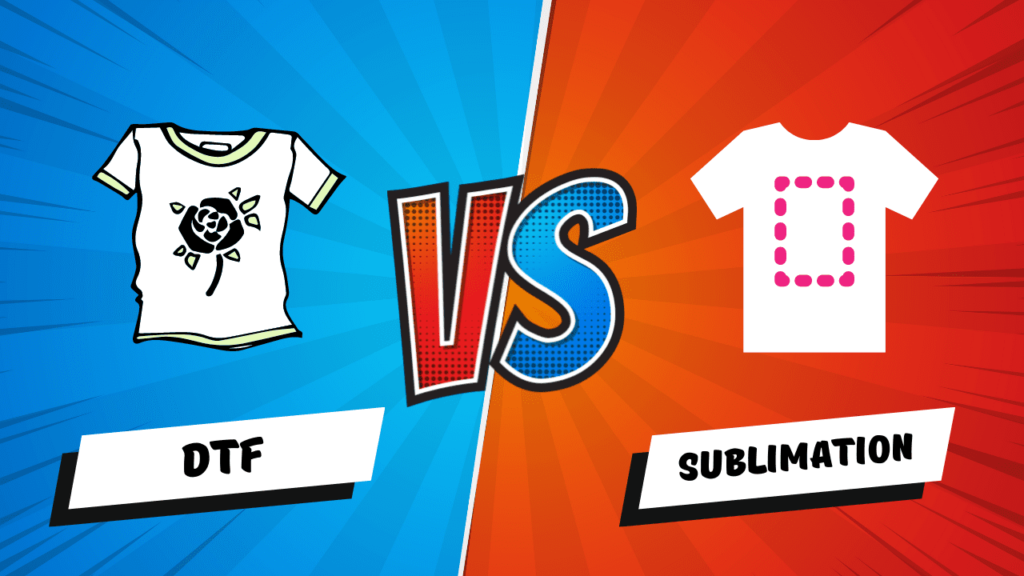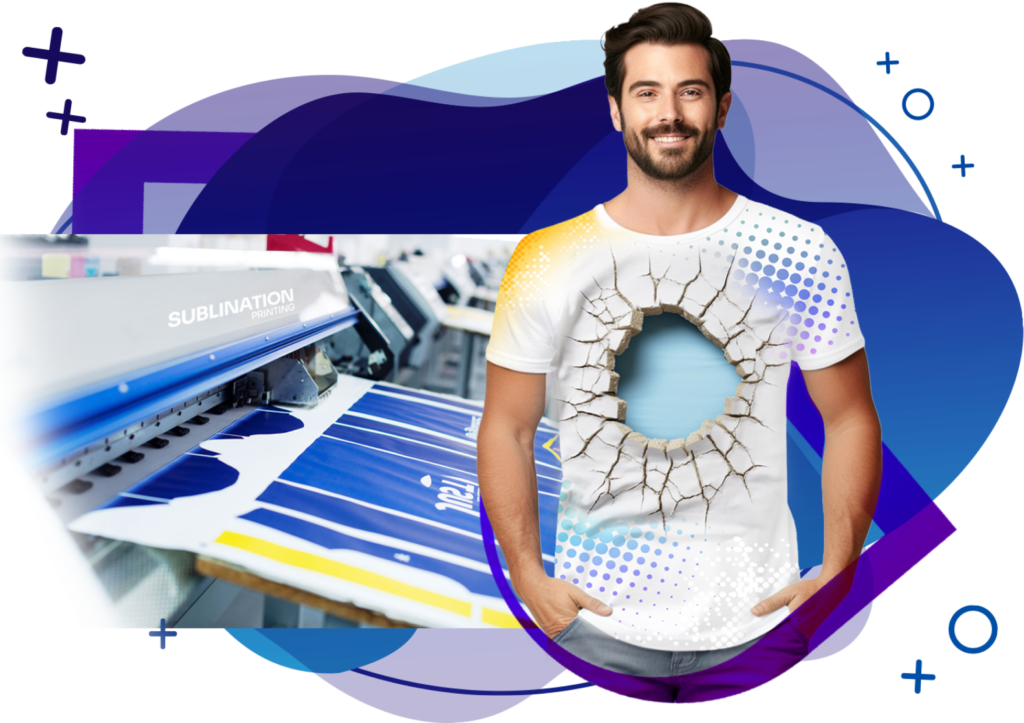
Introduction
The choice between Sublimation and DTF (Direct-to-Film) printing goes beyond the surface-level examination, in the ever-evolving realm of textile printing. Each method weaves its unique thread into the fabric of the industry, offering distinct advantages and disadvantages.
As we set forth on this exploration, let’s delve into the intricacies of DTF and Sublimation printing, investigating their subtleties, applications, and the delicate interplay between simplicity and dynamism.
DTF Printing: Precision with a Purpose
Direct-to-Film (DTF) printing operates at the intersection of precision and simplicity. It’s a method that involves printing a design directly onto a specialized film, which is then transferred onto the fabric using heat and pressure. Its straightforward process is simple: print, transfer, and you’re done. Yet, within this simplicity, a precision craftsmanship unfolds.
Advantages of DTF Printing:
1. Versatility in Fabric Types:
DTF exhibits impressive flexibility in working with various fabric types. Whether it’s cotton’s soft touch or polyester’s sleek feel, DTF can accommodate diverse materials, providing a wide canvas for creativity.
2. Detailed Designs and High Resolution:
The beauty of DTF lies in its ability to handle intricate designs with finesse. The direct film transfer method ensures high-resolution prints, precisely capturing the subtleties of fine lines and complex patterns.
3. Durable and Long-Lasting Prints:
DTF prints are known for their durability and resistance to fading, making them suitable for applications where longevity is key. The direct transfer of the film results in images that withstand the test of time.
Disadvantages of DTF Printing:
1. Initial Investment Costs:
While DTF offers versatility, entering this printing method requires a notable initial investment. Specialized DTF printers and films come with a price tag that might be a consideration for businesses, especially smaller ones.
2. Limited Application on Curved Surfaces:
The straightforward nature of DTF printing encounters challenges when faced with highly curved or irregularly shaped surfaces. Achieving seamless prints on such surfaces might be a bit of a hurdle.
3. Time-Consuming Process for Large Orders:
While efficient for small to medium production runs, the direct film transfer process can become time-consuming when dealing with larger orders. The meticulous nature of DTF printing takes its time, demanding patience for those seeking efficiency in high-volume printing.
Sublimation Printing: The Burst of Colorful Chemistry

Sublimation printing, in contrast, is a burst of colorful chemistry. It’s a process that involves transforming solid dye particles into a gas, which then bonds with the fabric at a molecular level. This molecular dance creates vibrant, all-over prints that become an integral part of the fabric, offering a spectrum of possibilities.
Advantages of Sublimation Printing:
1. Vibrant and Long-Lasting Colors:
Sublimation is renowned for its ability to produce vibrant colors that remain vivid over time. The molecular integration of dye with the fabric ensures immediate colour brilliance and resilience against fading after multiple washes.
2. All-Over Printing Capability:
Sublimation shines in the realm of all-over prints. It’s the go-to method for designs that span the entirety of the fabric, creating visually impactful and continuous patterns, especially on garments and textiles.
3. Cost-Effective for Large Production Runs:
Economically, Sublimation becomes more cost-effective when dealing with large production runs. The efficiency of the process and the ability to produce a high volume of items with the same design contribute to its cost-effectiveness.
Disadvantages of Sublimation Printing:
1. Limited Fabric Compatibility:
Sublimation’s magic is most potent on synthetic fabrics, particularly polyester. While it excels in its niche, it lacks the versatility that DTF printing offers concerning various fabric types.
2. Color Limitations and Matching Challenges:
Achieving precise color matches can be a challenge in sublimation printing. Some colors may present difficulties, and the gamut of available sublimation inks may have limitations, impacting the exact replication of certain hues.
3. Equipment and Consumable Costs:
The setup for sublimation printing involves specialized printers, heat presses, and specific consumables like inks and transfer papers. While cost-effective in large runs, the initial investment and ongoing consumable expenses may be higher than other printing methods.
Beyond the Basics: Choosing Your Printing Path
In choosing between DTF and Sublimation printing, the decision-making process involves carefully considering factors beyond the surface-level advantages and disadvantages. Both methods contribute uniquely to the rich tapestry of textile printing, offering options that cater to different needs, preferences, and creative visions.
Fabric Compatibility:
DTF: A canvas that accommodates a spectrum of fabrics, from the traditional to the contemporary.
Sublimation: A specialist in synthetic fabrics, particularly polyester, offering a burst of color brilliance.
Design Complexity:
DTF: The craftsman’s tool for intricate and detailed designs, handling the subtleties with precision.
Sublimation: The artist’s palette for all-over prints, allowing for bold and continuous patterns.
Cost Considerations:
DTF: A consideration for those willing to invest upfront for versatility and precision.
Sublimation: A cost-effective choice for those dealing with large production runs and seeking vibrant, lasting colors.
Application Efficiency:
DTF: Efficient for small to medium production runs, excelling in meticulous precision.
Sublimation: Economically efficient for large runs, offering speed and all-over printing capability.
Weaving Your Unique Fabric
As we navigate the intricate landscape of DTF and Sublimation printing, the choice between these methods becomes a highly individualized decision. It’s not just about weighing the pros and cons; it’s about aligning the chosen method with the unique needs and aspirations of each creative journey.
Artistry and Precision:
DTF printing emerges as the tool for artists and craftsmen seeking precision. Its versatility and ability to capture intricate details make it the chosen path for those who believe in the artistry of meticulousness.
Boldness and Expression:
Sublimation printing stands as the canvas for the bold and expressive. Its burst of colour and all-over printing capability make it the preferred choice for those who see textiles as a medium for vibrant, continuous expression.
Tailoring Your Printing Path:
In the tapestry of textile printing, every thread counts. Whether it’s the precision of DTF or the burstiness of Sublimation, the choice is not just a technical decision; it’s a creative declaration. It’s about tailoring your printing path to suit the fabric of your vision, allowing your creativity to weave a unique story in every print.
Beyond the Binary: Hybrid Approaches and Emerging Trends
In the ever-evolving landscape of textile printing, it’s worth noting that the story doesn’t end with a binary choice between DTF and Sublimation. Hybrid approaches, combining the strengths of different methods, are emerging as a trend. Some creators find that blending the precision of DTF with the burstiness of Sublimation allows for a broader range of creative possibilities.
The Future Unraveled: Innovations on the Horizon
As technology advances, so does the landscape of textile printing. Innovations in both DTF and Sublimation methods continue to unfold, promising enhanced efficiency, reduced costs, and expanded capabilities. Whether it’s advancements in ink technology, improvements in equipment, or the exploration of new materials, the future of textile printing holds exciting prospects.
Navigating Your Creative Horizon
The choice between DTF and Sublimation printing is a journey into the heart of creativity and functionality. As a creator, you navigate not just the technicalities of each method but the expansive landscape of your own imagination. Whether you find solace in the precision of DTF or the burstiness of Sublimation, the textile printing horizon is yours to explore and shape.
Looking ahead, the future of textile printing holds promises of continued innovation. Technological advancements, improved ink formulations, and exploration into new materials hint at an exciting horizon. The dialogue between simplicity and complexity in textile printing methods is evolving, creating a space for creators to push boundaries and redefine the norms.
Determining the environmental friendliness of Direct-to-Film (DTF) printing versus Sublimation printing involves considering various factors in each method. While both technologies have their environmental implications, assessing their eco-friendliness depends on specific practices and materials used. Here’s a breakdown:
Direct-to-Film (DTF) Printing:
Advantages:
- Water-Based Inks: DTF often utilizes water-based inks, which can be less environmentally harmful than solvent-based inks.
- Reduced Material Wastage: DTF allows for more precise printing, potentially reducing material wastage compared to traditional methods.
Considerations:
- Chemical Pre-Treatment: DTF requires a pre-treatment process involving chemicals, and the environmental impact depends on the types and quantities of these chemicals.
- Energy Consumption: The energy efficiency of DTF printers can impact the overall environmental footprint.
Sublimation Printing:
Advantages:
- No Water Usage in Printing: Sublimation printing doesn’t require water during the printing process, which can be an environmental benefit.
- Long-Lasting Prints: Sublimation creates durable prints, potentially reducing the need for replacements and minimizing long-term environmental impact.
Considerations:
- Energy Consumption: Sublimation involves heat pressing, which consumes energy. However, advancements in technology have led to more energy-efficient equipment.
- Special Inks and Transfer Papers: Sublimation uses specific inks and transfer papers, and the environmental impact depends on the composition of these materials.
Environmental Impact Comparison:

Both DTF and Sublimation have their environmental pros and cons. Choosing the more environmentally friendly option depends on specific practices within each method, ink formulations, pre-treatment processes, energy efficiency, and material choices.
Tips for Environmentally Friendly Printing:
- Eco-Friendly Inks: Choose inks with minimal environmental impact, considering factors like water-based formulations and reduced chemical content.
- Recycling Programs: Implement recycling programs for consumables like ink cartridges and ensure responsible waste disposal.
- Energy-Efficient Equipment: Select printers and heat presses with energy-efficient features to minimize energy consumption.
- Sustainable Materials: Incorporate sustainable practices, such as using recycled or organic fabrics, to further reduce the environmental footprint.
Conclusion
In the dynamic interplay between simplicity and complexity, creators find not just a choice of methods but a reflection of their own artistic philosophy. Whether one opts for the precision of DTF or the dynamism of Sublimation, the textile printing journey becomes a personal narrative, woven with threads of creativity and functionality. As the industry continues to evolve, navigating not only the technicalities but also the expansive landscape of imagination becomes paramount.
Ultimately, the unravelling of threads in textile printing is not just about the choice of methods; it’s about the stories we tell with each print. Whether it’s the craftsman meticulously shaping details with DTF or the artist painting with vibrant bursts through Sublimation, each method becomes a brushstroke on the canvas of creation. In this vast tapestry of possibilities, creators are invited to explore, experiment, and weave fabrics that not only adorn the world but also carry the essence of their unique vision.